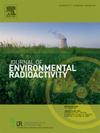Numerical simulation study on the radon exhalation mechanism of building walls influenced by coupled heat-moisture-air transfer
IF 1.9
3区 环境科学与生态学
Q3 ENVIRONMENTAL SCIENCES
引用次数: 0
Abstract
Building materials are one of the main sources of indoor radon, study of radon exhalation from building walls is of great reference significance for indoor radiation protection. Radon exhalation from building walls is comprehensively affected by environmental factors. A radon migration and exhalation model of building walls under the influence of coupled heat-moisture-air transfer was established. The radon exhalation mechanism of an aerated concrete wall under the influence of different relative humidity, temperature, relative humidity difference, temperature difference, air pressure difference and solar radiation was studied. The sensitivity of these factors to radon exhalation rate was analyzed. The results showed that the radon exhalation rate was positively correlated with relative humidity, but not with temperature; The radon exhalation rate was positively correlated with the relative humidity difference, and the temperature affected the correlation degree; The radon exhalation rate was positively correlated with the absolute temperature difference, and the relative humidity affected the correlation degree; The exhalation rate of radon was approximately linearly positive correlated with the pressure difference; Under the influence of solar radiation, the radon exhalation rate decreased; Radon parameters of material, relative humidity and solar radiation were more sensitive to radon exhalation rate than temperature, air pressure and radon concentration in air. For reducing radon exhalation rate of building walls and indoor radon concentration, we propose to use building wall materials with low radium content, keep indoor relative humidity and indoor and outdoor temperature difference low, and strengthen indoor ventilation at night, cloudy and rainy days.
热-湿-风耦合传热对建筑墙体氡释放机理影响的数值模拟研究
建筑材料是室内氡的主要来源之一,研究建筑墙体的氡释放对室内辐射防护具有重要的参考意义。建筑墙体的氡释放受环境因素的综合影响。建立了热湿-空气耦合传热影响下建筑墙体氡迁移呼出模型。研究了不同相对湿度、温度、相对湿度差、温差、气压差和太阳辐射对加气混凝土墙体氡析出机理的影响。分析了这些因素对氡呼出率的敏感性。结果表明:氡呼出率与相对湿度呈正相关,与温度不相关;氡呼出率与相对湿度差呈正相关,温度影响相关程度;氡呼出率与绝对温差呈正相关,相对湿度影响其相关程度;氡的呼出率与压差呈近似线性正相关;在太阳辐射的影响下,氡的呼出率降低;材料氡参数、相对湿度和太阳辐射对氡呼出率的敏感性高于温度、气压和空气中氡浓度。为降低建筑墙体氡呼出率和室内氡浓度,建议采用低镭含量的建筑墙体材料,保持较低的室内相对湿度和室内外温差,并在夜间、阴天和雨天加强室内通风。
本文章由计算机程序翻译,如有差异,请以英文原文为准。
求助全文
约1分钟内获得全文
求助全文
来源期刊

Journal of environmental radioactivity
环境科学-环境科学
CiteScore
4.70
自引率
13.00%
发文量
209
审稿时长
73 days
期刊介绍:
The Journal of Environmental Radioactivity provides a coherent international forum for publication of original research or review papers on any aspect of the occurrence of radioactivity in natural systems.
Relevant subject areas range from applications of environmental radionuclides as mechanistic or timescale tracers of natural processes to assessments of the radioecological or radiological effects of ambient radioactivity. Papers deal with naturally occurring nuclides or with those created and released by man through nuclear weapons manufacture and testing, energy production, fuel-cycle technology, etc. Reports on radioactivity in the oceans, sediments, rivers, lakes, groundwaters, soils, atmosphere and all divisions of the biosphere are welcomed, but these should not simply be of a monitoring nature unless the data are particularly innovative.
 求助内容:
求助内容: 应助结果提醒方式:
应助结果提醒方式:


